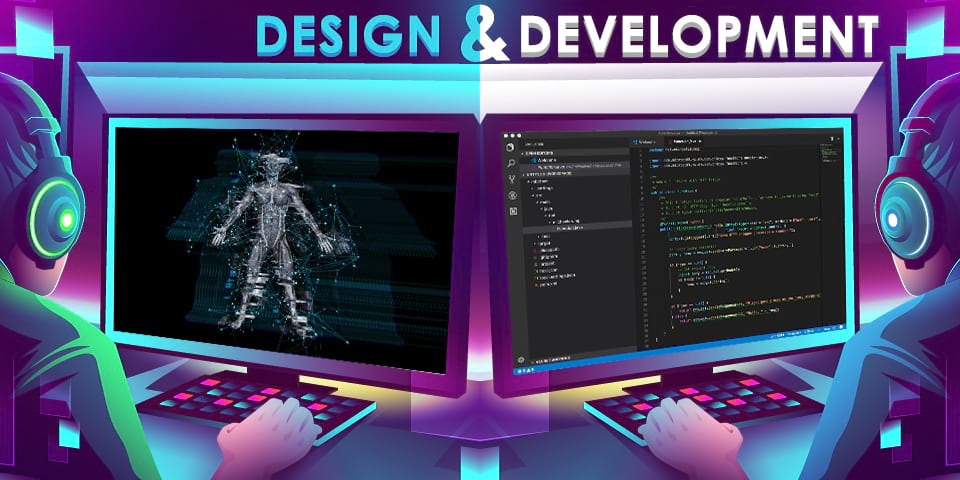Understanding Game Design vs Game Development
Learn the key differences between game design and game development. This guide explains the roles, responsibilities, and skills involved in each discipline.

For many gamers, playing the latest groundbreaking title on their console or PC offers an escape into fantastical worlds where imagination reigns free. But few pause to contemplate the intricate creative processes that must harmonize to transform an idea into an interactive digital experience.
At its core, building a video game encompasses two fundamental phases - game design and game development. While the terms are sometimes used interchangeably, they represent distinct creative focuses that must align to birth memorable virtual worlds.
This article will navigate the nuances between these two cornerstones of game creation, providing insight into how they shape the player experience. We’ll also showcase how an experienced game development company can optimize this symbiotic relationship to craft engrossing interactive art.
Let’s jump in!
Game Design
Game design forms the nucleus of the development process. This crucial phase aims to craft engaging core mechanics, narrative arcs, and gameplay loops that will hook players.
Designers from a reputed game development company would pour their creative energies into several key tasks:
Conceptualizing Gameplay
The starting point is dreaming up innovative genres, mechanics, challenges, and obstacles that will define the game’s interactive flow. Whether it’s platforming, puzzles, or warfare, the designer’s role is to deliver new twists that captivate gamers.
Worldbuilding and Storytelling
Designers also focus intensely on narrative and lore, aiming to build immersive worlds where the mechanics can thrive. Environments, characters, dialogue, and themes must align to provide players with motivation and purpose.
Systems Design
The designer also crafts intricate rule systems that govern difficulty, progression, losses, gains, and ultimate victory/defeat states. These schemes must challenge gamers while enabling balanced advancement.
Documentation
Finally, designers encapsulate their broad vision within game design documents (GDDs). These specifications will guide developers in actualizing the creative vision.
Game Development
With solid design documents as their guide, game developers shift focus toward technical implementation. Utilizing programming proficiency across tools like Unity, Unreal Engine, etc, their goal is to translate visual concepts and written ideas into functional realities.
Key responsibilities include:
Engineering Core Mechanics
Developers collaborate with designers to engineer the mechanics that drive moment-to-moment engagement. This means coding systems for movement, combat, progression, artificial intelligence, etc.
Building Narrative Structures
Development teams also construct narrative sequences, dialogue trees, cinematic events, and lore reveals based on the intended storyline.
Prototype Iteration
Regular collaboration with designers enables the creation of playable prototypes that showcase core mechanics and narrative beats. Teams then polish and optimize based on feedback.
Integrating Art Assets
Seamlessly blending animation, visual effects, sound design, and music with interactivity also falls within the developer’s domain.
Optimization and Testing
From ensuring engaging difficulty progression to diagnosing bugs, developers work iteratively to guarantee polished gameplay before launch.
The Value of Experienced Game Studios
For publishers eyeing their own breakout hit, finding a game development company that perfectly balances design creativity and technical expertise can be transformational.
Veteran teams draw from years of experience across genres and platforms to actualize projects seamlessly from start to finish.
Here are some key benefits they provide:
Holistic Mastery
Game designers, developers, and artists harmonize their talents into a unified creative force, executing every phase with care and skill.
Streamlined Workflows
Robust project management, clear documentation, and optimized asset pipelines enable rapid yet structured development.
Realistic Scoping
They identify the most vital elements that will create lasting player engagement while remaining within budget and time constraints.
Technological Finesse
Teams skillfully utilize leading game engines and development frameworks to engineer modern interactive systems.
Post-Launch Support
Even after launch, they continue polishing and enhancing games via updates, bug fixes, new content, etc to prolong engagement.
By utilizing such proficiencies nurtured over nearly a decade of game creation, you can repeatedly craft titles that resonate profoundly with players worldwide.
Craft Your Gaming Vision!
And there you have it folks - a high-level overview of how game design and development meld together within interactive entertainment.
We hope this piece provided insight into how harmonizing these skill sets can birth memorable gaming adventures and help you make an impact in this rapidly progressing industry,
Read more: Top Crypto Games in 2025













